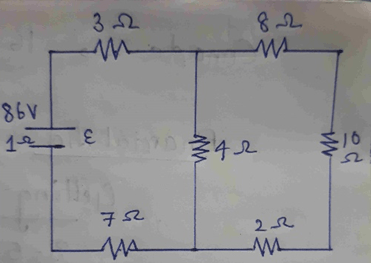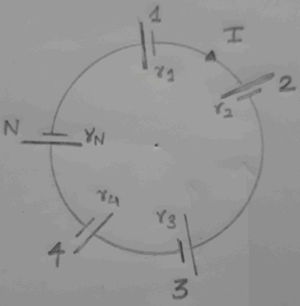This set of Class 12 Physics Chapter 3 Multiple Choice Questions & Answers (MCQs) focuses on “Current Electricity – Cells, Emf and Internal Resistance”.
1. Which of the following is the correct statement regarding electrochemical cell?
a) It converts chemical energy to electrical energy
b) It converts electric energy to chemical energy
c) It converts chemical energy to thermal energy
d) It does not maintain the flow of charge in a circuit
View Answer
Explanation: An electrochemical cell is a device which converts chemical energy to electric energy, and maintains the flow of charge in a circuit. There are 2 types of electrochemical cells – Galvanic cell and Electrolytic cell.
2. Pick out the dimensional formula of emf from the following.
a) [M1L2T3A1]
b) [ML3T3A1]
c) [M2L2T1A-1]
d) [ML2T-3A-1]
View Answer
Explanation: Electromotive force (emf) is defined as the potential difference between the two terminals of a cell in an open circuit. The SI unit of emf is \(\frac {joule}{coulomb}\) or volt. So, its dimensional formula is [ML2T-3A-1].
3. Which is the factor that internal resistance does not depend on?
a) Distance between the electrodes
b) Temperature of the electrolyte
c) Nature of electrode and electrolyte
d) Area of the electrode, immersed in the electrolyte
View Answer
Explanation: Internal resistance is defined as the resistance offered by the electrolyte and electrodes of a cell when the current flows through it. Internal resistance depends on distance between the electrodes, the nature of electrodes and electrolyte, and area of the electrode immersed in the electrolyte. So, that leaves temperature of the electrolyte out, which is the answer.
4. The emf of a cell depends upon concentration of the electrolyte.
a) True
b) False
View Answer
Explanation: The emf of a cell depends upon the nature of electrodes, nature and concentration of electrolyte used in the cell and its temperature as well. Emf of a cell is inversely proportional to the concentration of the electrolyte.
5. Identify the correct statement from the following about discharging of a cell.
a) The direction of current in the cell is from positive to negative terminal
b) Terminal potential difference is greater than emf of the cell
c) Terminal potential difference is lesser than emf of the cell
d) The current increases and decreases frequently
View Answer
Explanation: During discharging of a cell terminal potential difference, the terminal potential difference is lesser than the emf of the cell. The direction of current inside the cell is from negative terminal to positive terminal.
6. A current of 3 A passes through an electric circuit for 5 minutes and does a work of 900J. What is the emf of the source?
a) 3V
b) 1V
c) 5V
d) 10V
View Answer
Explanation: Current = 3 A; Time taken = 5 minutes = 300 seconds
Work done = 900 J; Power = \(\frac {Work \, done}{Time \, taken} = \frac {900}{300}\) = 3 W
Power = Voltage (emf) x Current → Emf = \(\frac {Power}{Current} = \frac {3}{3}\) = 1V
Therefore, the emf of the source is 1 volt.
7. The emf of a battery is 86V and internal resistance 1 ohms in the figure shown below. Calculate the current drawn from the battery.

a) 2 A
b) 3 A
c) 5 A
d) 6 A
View Answer
Explanation: The resistances 8 ohms, 10 ohms, and 2 ohms are in series, so the equivalent resistance is: RS = 8 + 10 + 2 = 20 ohms; RS and 4 ohms are in parallel connection to each other, so,
\(\frac {1}{R_P} = \frac {1}{20} + \frac {1}{4} = \frac {3}{10}\) → RP = \(\frac {10}{3}\)
Total resistance (R) = 3 + \(\frac {10}{3}\) + 7 + 1 (internal resistance) = \(\frac {43}{3}\)
According to Ohm’s Law → V = IR → I = \(\frac {V}{R} = \frac {86}{\frac {34}{3}}\)
= 3 × 2
= 6 A
Therefore, the current drawn from the battery is 6 amperes.
8. A cell has an emf of 6V, internal resistance of 1 ohms and a current of 0.5 A passing through it. This cell is connected to a resistor. Find out the resistance of the resistor.
a) 10 ohms
b) 11 ohms
c) 12 ohms
d) 13 ohms
View Answer
Explanation: Emf (e) = 6V; Internal resistance (r) = 1 ohms; Current (I) = 0.5A
Required equation: I = \(\frac {e}{R}\) + r
0.5 = \(\frac {6}{R}\) + 1
R = \(\frac {(6 – 0.5)}{0.5}\)
R = 11 ohms
Therefore, the resistance of the resistor is 11 ohms.
9. A group of N cells such its emf EN = 1.5rN is shown in the diagram below. What is the current I in the circuit?

a) 51 A
b) 0.015 A
c) 1.5 A
d) 155.1 A
View Answer
Explanation: The total emf can be calculated as: E = E1 + E2 + E3 + …………… + EN
(According to the relation given) = 1.5r1 + 1.5r2 + 1.5r3 + ………… + 1.5rN
= 1.5 (r1 + r2 + r3 + ………… + rN) → X
Total resistance can be calculated as: R = r1 + r2 + r3 + ……….. + rN → Y
Substituting Y in X
E = 1.5 × R
We also know that → I = \(\frac {E}{R}\)
So, I = \(\frac {E}{R}\) = 1.5 A
Therefore, the current in the circuit = 1.5 ampere
10. Which of the following devices is the more accurate one for the measurement of emf?
a) Meter Bridge
b) Voltmeter
c) Multimeter
d) Potentiometer
View Answer
Explanation: Potentiometer is the more accurate device to measure emf than the other ones such as multimeter or voltmeter. Potentiometer is highly sensitive and thus, even small emfs can be measured using this device. Moreover, potentiometers do not draw current from the circuit during measurements, like voltmeters.
Sanfoundry Global Education & Learning Series – Physics – Class 12.
To practice all chapters and topics of class 12 Physics, here is complete set of 1000+ Multiple Choice Questions and Answers.
If you find a mistake in question / option / answer, kindly take a screenshot and email to [email protected]
- Practice Class 12 - Mathematics MCQs
- Practice Class 12 - Biology MCQs
- Practice Class 11 - Physics MCQs
- Practice Class 12 - Chemistry MCQs
- Check Class 12 - Physics Books
